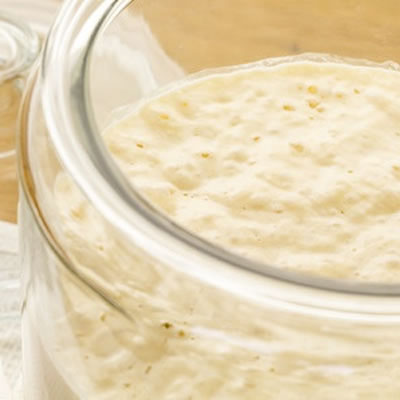
Biga是发酵的面团
比加
什么是biga?
比加is a type of preferment or yeast starter that does not include salt in its preparation, only flour, water and yeast. It is a stiff preferment due to its lower hydration level, usually in the range of 50–60% water absorption. Biga is to the Italians as poolish is to the French.
Biga用于:
- Improving the functionality of gluten and strengthening dough
- 用较少的酵母缩短最终发酵时间
- 增强香气和风味
- 使面团成熟并增加一致性
- 延长面包的保质期
Origin
This type of preferment was developed by Italian bakers. The production technique of biga was developed just a few years after the discovery of baker’s yeast.
在19世纪,欧洲的一些面包师为了采用更快的生产技术而离开了使用酸面团的使用,但需要恢复在该过程中放弃的一些风味和香气。
比加was then made fresh every day and added to recipes at different levels, depending on the formula, for routine production of traditional Italian bakery goods.1,2
Function
由于其坚硬的一致性(低水化水平),它为面团提供了强度,这实际上是其原始目的。由Biga制成的面包由于其长发酵时期具有复杂的味道。
The long fermentation occurs because the yeast’s movement and metabolic activity are impeded or slowed down by the low level of free water available. Yeast also propagates slower and partially consumes the carbohydrates in the dough.
BIGA通常用于需要轻巧和开放结构的面包中,即更多的细胞。由于其较高的酸度水平或较低的pH值,它通过延长其保质期有助于保存面包。
生产:3
传统的Biga是通过使用面粉,水和酵母准备的。数量可以如下:
- 面包粉:100%
- 水:50–60%
- 新鲜酵母:0.8–1.5%或
- 即时酵母:0.1%
混合物仅混合以形成均匀的面团(在这种情况下,全麸质发育不是目标),然后在15–20°C(59-68°F)的温度下发酵8-16小时。
发酵条件(时间,温度)可以根据面包师的便利性和准备的面包类型进行调节。成熟后,它将被围绕,并刚刚开始退缩。
Application
当对Biga进行正确的发酵时,将剩余的面粉和水添加在面团侧。30–60分钟的底部时间后,面团被分割/切割,形状,并在最后一次证明30-60分钟,然后烘烤。
面包师在使用更强壮的面粉时应仔细使用BIGA,以避免损害可扩展性。如果面团可扩展性受到损害,则水合较高或自动will help regain a better balance.1
BIGA用于生产各种面包店,其中包括:
- CiaiBatta(最终面团配方中的40%BIGA)
- 鞋垫
- 德式圣诞蛋糕
- Filoncini burro y nocci (20% biga in final dough formula)
- 面包由高湿面团制成
- 丹麦面团(最终面团配方中的67%BIGA)
参考
- Suas, M. “Fermentation.” Advanced Bread and Pastry: A Professional Approach, Delmar, Cengage Learning, 2009, pp. 86–88.
- 斯特拉烹饪,“三个母亲的偏爱以及如何使用它们。”https://stellaculinary.com/content/three-mother-preferments-and-how-use-them。2018年3月30日访问。
- Hamelman,J。Bread - 贝克的技术和食谱书,2004年,第1页。105。

发表评论